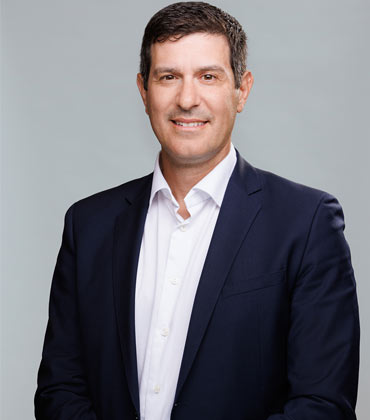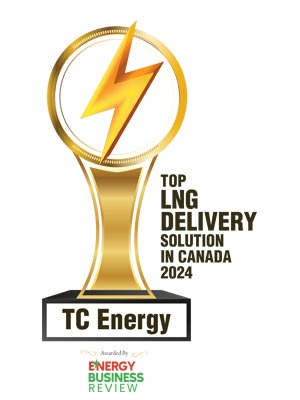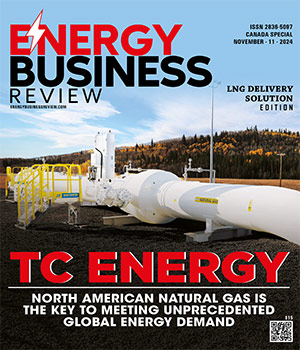Thank you for Subscribing to Energy Business Review Weekly Brief
Our world is rapidly changing. As global populations continue to grow, demand for energy has never been greater. One of the most powerful tools in tackling this challenge is natural gas, which offers an immediate and long-lasting solution. North America’s abundant supply of natural gas is recognized as a key pillar of our energy future and is produced to the highest ESG standards in the world. For nations throughout Europe and Asia confronting energy shortages, North American natural gas can offer a secure and reliable energy solution to meet shared emissions reduction goals. TC Energy, one of North America’s leading energy infrastructure companies, is working to deliver that solution. The company transports more than 30 per cent of the cleaner-burning natural gas to meet global demand, connecting the biggest and best supply basins in North America to the world. “With nearly one billion people living in the world today without access to affordable and reliable energy – and an additional one-and-a-half to two billion people that are going to join the world between now and 2045, we absolutely need more natural gas. It is going to be critical going forward,” says Stanley Chapman III, TC Energy, Executive Vice-President and Chief Operating Officer, Natural Gas Pipelines. “Natural gas is the reliable, instantaneous dispatch, day or night, rain or shine, 24 hours a day, seven days a week answer to that demand.” A highly strategic footprint Today, TC Energy is delivering solutions to the world’s toughest energy challenges – including feeding LNG to global markets, reducing emissions and partnering with neighbors, customers and governments to build the energy system of the future. One of TC Energy’s advantages is its extensive and unrivalled asset footprint. It is the only natural gas infrastructure company to operate across all three countries in North America –delivering energy to Canada, the U.S. and Mexico, and through LNG exports, around the world. In its power and energy solutions segment, TC Energy’s strategy includes a 48.4 per cent ownership stake in Bruce Power, which provides 30 per cent of Ontario’s electricity. Nuclear energy offers a reliable, low-carbon power source crucial for balancing grid demand and integrating renewable energy sources. The company’s strategic footprint allows TC Energy to offer an immediate and enduring solution to help reduce global emissions and capitalize on natural synergies between its natural gas and power businesses.
Premier Energy Consultant
Compression Dynamics Consulting is an engineering consulting firm that specializes in rotor dynamics in the oil and natural gas industry. “Although we provide consultation on any rotating and reciprocating equipment, we excel at pulsation analysis, torsional analysis, and dynamic field vibration analyses,” says Chris Miller, managing partner, Compression Dynamics Consulting. Compression Dynamics Consulting seamlessly conducts field vibration analyses, and this is one of the biggest differentiators of the company in the market. To ensure an accurate diagnosis, the company goes on-site and gathers vibration, pulsation, and performance data. This is done utilizing accelerometer, velocity, and transducer probes at critical points of interest. “We typically conduct thorough and complicated studies. Our team does not simply provide recommendations to clients and wash their hands of them. We address the issues clients are experiencing,’’ says Miller. This capability to go out in the field and use vibration probes is a competitive advantage for Compression Dynamics Consulting. Unlike other firms that conduct engineering and analytical studies, the company has the expertise to verify the results or look at vibration data to decipher the discrepancies. Prefabrication analysis is another key area of focus for Compression Dynamics Consulting. The company analyzes pre-fabrication drawings of equipment to ensure everything runs smoothly with acceptable vibration. Compression Dynamics Consulting is outfitted with the best analytical software available, and their results have been field-tested and validated. A few examples of cutting-edge tools the firm utilizes are Autodesk, Pulsim Suite, ANSYS, and Caesar II. Using these technologies, Compression Dynamics Consulting provides its clients with reliable, up-to-date insights into their system dynamics.
Helping Achieve Environmental Objectives
Human beings produce vast amounts of garbage on a daily basis. For years, the conventional method of dealing with municipal solid waste has been to transport it to landfills. However, landfills present numerous issues—they fill up quickly, require significant space, contaminate water and soil, and emit methane, a potent greenhouse gas. In addition, a significant amount of the waste remains stagnant for centuries, posing long-term environmental challenges. But what if we could use this waste as a resource? For instance, the organic fraction of waste could be separated and transformed into biofuel, coal replacement, Renewable Natural Gas (RNG), a soil enrichment or building materials? However, a substantial portion of this, around 50 to 60 percent, still ends up in landfills. Merely targeting the food waste fraction overlooks valuable digestible materials that could contribute to methane production in landfills over time and exacerbate the existing environmental issues associated with traditional waste disposal methods. As a result, it is crucial to develop advanced waste-to-energy technologies to effectively reduce the amount of municipal solid waste ending up in landfills and minimize the environmental impact. Enter WastAway, a pioneering green technology company that has developed innovative solutions to transform municipal solid waste into a safe, inert, and sterile carbon-rich sustainable engineered fuel called SE3™. It is homogeneous, pathogen-free and odor-free. Its renewable – negative carbon footprint – products include a soil enrichment additive; a proven, high-BTU coal replacement fuel for cement kilns, power plants, steel mills, pulp mills and other solid fuel users; biofuels through gasification and pyrolysis; renewable natural gas (RNG) through anaerobic digestion and building materials through extrusion processes. “We take municipal solid waste as our initial feedstock, offering a solution for those seeking alternatives to landfills. Our technology stands as one of the few in the world capable of legitimately diverting 85 percent of waste from a typical waste stream into valuable and beneficial products,” said Mark Brown, CEO of WastAway. The process begins with the extraction of municipal solid waste from curb side collection trucks. This involves sorting waste that has already undergone segregation by end-users in recycling programs. In regions lacking such programs, it handles the collected waste stream from street-side bins. The initial step in its operation is mixed recovery facilities (MRF), which entails extracting recyclables like ferrous metals, aluminum, non-ferrous metals, and polyethylene terephthalate (PET) plastics. These materials are then directed to local recycling centers or industries with corresponding markets.
CXO INSIGHTS

Renewable and low-carbon gases are a viable avenue towards a cleaner energy future
Joe Mazza, Vice-President of Energy Supply and Resource Development, FortisBC

A Vision for Renewable Energy Innovation
Heather Patti, Senior Associate at Montrose Environmental Group, Inc.

More Collaboration Needed In a Rapidly Growing Solar Industry
Stephen Branscum, Senior Energy Manager, Walmart[NYSE: WMT]

Charting the Path to Hydrogen Economy for a Sustainable Tomorrow
Henry Hui, Corporate VP, H2 Strategy & Energy Infrastructure, Nikkiso Clean Energy & Industrial Gases

The Evolution and Integration of Renewable Energy
Jim Helvig, P.E., Vice President of Operations, Dashiell Corporation
IN FOCUS
Latest Developments in Alternative Fuels
The ongoing developments in battery technology and electric powertrains make electric vehicles more accessible, efficient, and sustainable.
Cutting-Edge Delivery Solutions For A Greener Future
The liquefied natural gas (LNG) industry has undergone significant transformations in recent years
EDITORIAL
The Role of Technology and Innovation in the Energy Shift
The Liquefied Natural Gas (LNG) delivery solutions space is witnessing rapid advancements, driven by the global energy transition, a growing need for cleaner fuels, and significant technological breakthroughs. As the world moves toward greener energy solutions, LNG has emerged as a critical alternative to traditional fossil fuels, and its transportation infrastructure is evolving to meet the demands of this shift. One of the most exciting trends is the rise of small-scale LNG (ssLNG) delivery solutions. Traditionally, LNG was associated with large-scale infrastructure, but as industries and regions push for decarbonization, the demand for smaller, more flexible delivery systems has grown. ssLNG enables more localized deliveries, serving remote areas that lack pipeline infrastructure or major LNG terminals. This trend also benefits industries like marine transportation, where vessels require LNG bunkering in various ports that may not have large LNG storage facilities. The digital revolution is making its mark on LNG delivery, with automation and digital platforms enhancing every stage of the supply chain. Smart sensors, data analytics, and blockchain technology are now integral to the operation of LNG carriers, allowing for real-time tracking of fuel conditions, safety measures, and route optimization. The LNG delivery solutions space is in the midst of a dynamic transformation. From the rise of small-scale LNG and FSRUs to advancements in digitalization, cryogenics, and sustainability, the industry is rapidly evolving to meet the changing demands of a cleaner, more connected energy future. As new technologies and fuel sources like hydrogen enter the mix, LNG delivery solutions are becoming more flexible, efficient, and environmentally friendly — reinforcing LNG’s role as a key player in the global energy transition. In this edition, we have featured TC Energy. It is one of North America’s leading energy infrastructure companies, is working to deliver that solution. The company transports more than 30 per cent of the cleaner-burning natural gas to meet global demand, connecting the biggest and best supply basins in North America to the world.










